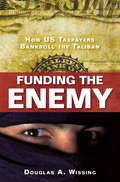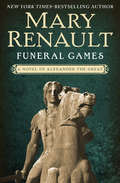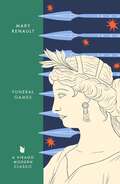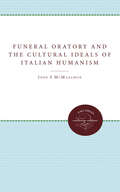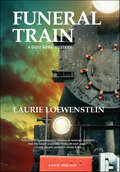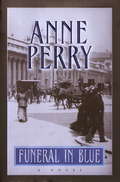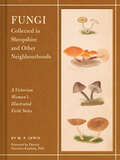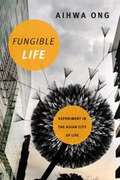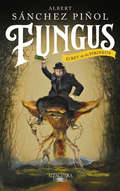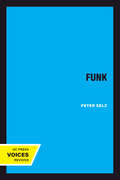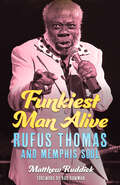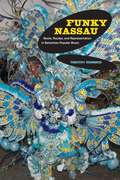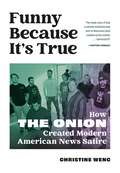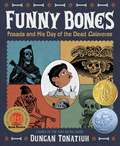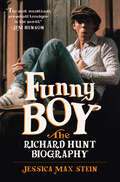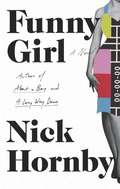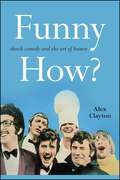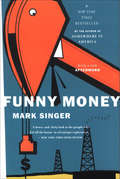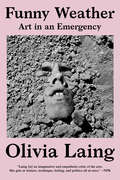- Table View
- List View
Funding the Enemy
by Douglas A. WissingWith the vague intention of winning hearts and minds in Afghanistan, the US government has mismanaged billions of development and logistics dollars, bolstered the drug trade, and dumped untold millions into Taliban hands. That is the sobering message of this scathing critique of our war effort in Afghanistan. According to this book, America has already lost the war. While conducting extensive research and fieldwork in Afghanistan's war zones, a drumbeat of off-the-record and offhand remarks pointed the author to one conclusion: "We blew it." The sentiment was even blazoned across a US military fortification, as the author saw at Forward Operating Base Mehtar Lam in insurgency-wracked Laghman Province: "I glanced over at a concrete blast barrier while waiting for a helicopter," Wissing says. "Someone had spray-painted in jagged letters: 'The GAME. You Lost It.'" The author's vivid narrative takes the reader down to ground level in frontline Afghanistan. It draws on the voices of hundreds of combat soldiers, ordinary Afghans, private contractors, aid workers, international consultants, and government officials. From these contacts it became glaringly clear, as the author details, that American taxpayer dollars have been flowing into Taliban coffers, courtesy of scandalously mismanaged US development and counterinsurgency programs, with calamitous military and social consequences. This is the first book to detail the toxic embrace of American policymakers and careerists, Afghan kleptocrats, and the opportunistic Taliban. The result? US taxpayers have been footing the bill for both sides of a disastrous Afghanistan war.
Funeral Games: A Novel Of Alexander The Great: A Virago Modern Classic (The Novels of Alexander the Great #3)
by Mary RenaultThe conclusion to the New York Times–bestselling trilogy of ancient Greece by the author Hilary Mantel calls &“a shining light.&” By the end of his reign, Alexander the Great had seized control of an empire that extended from the Adriatic Sea to the Indus River. When he died in 323 BC, a fervent scramble for power ensued. Funeral Games is Mary Renault&’s remarkable novel of this turmoil and the gradual erosion of the Greek empire. The power players include Ptolemy, two father-son teams, and a cadre of influential women—not least of whom is Eurydike, whose plan is to marry Alexander&’s disabled brother, Arridaios. Brimming with outsize personalities, brazen plots, and a sweeping sense of history, Funeral Games brings to vivid life the world of Alexander the Great, and the seismic tumult in the wake of his death.Funeral Games is the final volume of the Novels of Alexander the Great trilogy, which begins with The Persian Boy and Fire from Heaven.This ebook features an illustrated biography of Mary Renault including rare images of the author. &“Mary Renault is a shining light to both historical novelists and their readers. She does not pretend the past is like the present, or that the people of ancient Greece were just like us. She shows us their strangeness; discerning, sure-footed, challenging our values, piquing our curiosity, she leads us through an alien landscape that moves and delights us.&” —Hilary Mantel
Funeral Games: A Novel of Alexander the Great: A Virago Modern Classic (Virago Modern Classics #317)
by Mary Renault'The Alexander Trilogy contains some of Renault's finest writing. Lyrical, wise, compelling: the novels are a wonderful imaginative feat' SARAH WATERSIn the final novel of her stunning trilogy, Mary Renault vividly imagines the life of Alexander the Great, the charismatic leader whose drive and ambition created a legend.Alexander the Great died at the age of thirty-three, leaving behind an empire that stretched from Greece and Egypt to India. After Alexander's death in 323 B.C. his only direct heirs were two unborn sons and a simpleton half-brother. Every long-simmering faction exploded into the vacuum of power. Wives, distant relatives and generals all vied for the loyalty of the increasingly undisciplined Macedonian army. Most failed and were killed in the attempt. For no one possessed the leadership to keep the great empire from crumbling. But Alexander's legend endured to spread into worlds he had seen only in dreams.'Mary Renault is a shining light to both historical novelists and their readers. She does not pretend the past is like the present, or that the people of ancient Greece were just like us. She shows us their strangeness; discerning, sure-footed, challenging our values, piquing our curiosity, she leads us through an alien landscape that moves and delights us' - HILARY MANTEL'The Alexander Trilogy stands as one of the most important works of fiction in the 20th century . . . it represents the pinnacle of [Renault's] career . . . Renault's skill is in immersing us in their world, drawing us into its strangeness, its violence and beauty. It's a literary conjuring trick like all historical fiction - it can only ever be an approximation of the truth. But in Renault's hands, the trick is so convincing and passionately conjured' Antonia Senior, The Times
Funeral Games: A Novel of Alexander the Great: A Virago Modern Classic (Vmc Ser. #88)
by Mary Renault'The Alexander Trilogy contains some of Renault's finest writing. Lyrical, wise, compelling: the novels are a wonderful imaginative feat' SARAH WATERSIn the final novel of her stunning trilogy, Mary Renault vividly imagines the life of Alexander the Great, the charismatic leader whose drive and ambition created a legend.Alexander the Great died at the age of thirty-three, leaving behind an empire that stretched from Greece and Egypt to India. After Alexander's death in 323 B.C. his only direct heirs were two unborn sons and a simpleton half-brother. Every long-simmering faction exploded into the vacuum of power. Wives, distant relatives and generals all vied for the loyalty of the increasingly undisciplined Macedonian army. Most failed and were killed in the attempt. For no one possessed the leadership to keep the great empire from crumbling. But Alexander's legend endured to spread into worlds he had seen only in dreams.'Mary Renault is a shining light to both historical novelists and their readers. She does not pretend the past is like the present, or that the people of ancient Greece were just like us. She shows us their strangeness; discerning, sure-footed, challenging our values, piquing our curiosity, she leads us through an alien landscape that moves and delights us' - HILARY MANTEL'The Alexander Trilogy stands as one of the most important works of fiction in the 20th century . . . it represents the pinnacle of [Renault's] career . . . Renault's skill is in immersing us in their world, drawing us into its strangeness, its violence and beauty. It's a literary conjuring trick like all historical fiction - it can only ever be an approximation of the truth. But in Renault's hands, the trick is so convincing and passionately conjured' Antonia Senior, The Times
Funeral Oratory and the Cultural Ideals of Italian Humanism
by John M. McManamonBy studying the funeral orations of Renaissance Italy, McManamon analyzes Italian humanism as a characteristic phase in Western rhetorical culture. By examining hundreds of funeral speeches, he provides a valuable overview of major civic issues and humanistic themes, adding significant new material to the history of rhetoric. When Italian humanists spoke at funerals, they took this unique opportunity to press for their reformist goals. Originally published in 1989.A UNC Press Enduring Edition -- UNC Press Enduring Editions use the latest in digital technology to make available again books from our distinguished backlist that were previously out of print. These editions are published unaltered from the original, and are presented in affordable paperback formats, bringing readers both historical and cultural value.
Funeral Train: A Dust Bowl Mystery
by Laurie LoewensteinIn her gripping follow-up to the widely acclaimed Dust Bowl Mystery Death of a Rainmaker, Laurie Loewenstein brings 1930s Oklahoma evocatively to life. *Winner of a Will Rogers Silver Medallion Award for Western Mystery *A finalist for the 2023 Killer Nashville Silver Falchion Award for Best Historical "For Temple Jennings, the small-town Oklahoma sheriff who returns in Laurie Loewenstein's engaging new Dust Bowl-era mystery, Funeral Train, day-to-day matters have become challenging . . . Reading Funeral Train feels like being catapulted back in time to experience the 1930s at an almost unbearably visceral level." —New York Times Book Review "Loewenstein handles the investigatory details well enough, but the book's richer rewards are its finely rendered portraits of small-town life under trying circumstances. She creates a vivid cast of gossips and cranks, loners and busy bodies. Some are lovable, some are not. All are connected to the secrets that lie just beneath the surface of the town's dusty streets." —Washington Post, one of "Five New Thrillers to Kick Off Your Fall Reading" Already suffering the privations of the 1930s Dust Bowl, an Oklahoma town is further devastated when a passenger train derails—flooding its hospital with the dead and maimed. Among the seriously wounded is Etha, wife of Sheriff Temple Jennings. Overwhelmed by worry for her, the sheriff must regain his footing to investigate the derailment, which rapidly develops into a case of sabotage. The following night, a local recluse is murdered. Temple has a hunch that this death is connected to the train wreck. But as he dissects the victim’s life with help from the recuperating and resourceful Etha, he discovers a tangle of records that make a number of townsfolk suspects in the murder. Temple’s investigations take place against the backdrop of the Great Depression—where bootlegging, petty extortion, courage, and bravado play out in equal measure.
Funeral in Blue: A William Monk Novel (William Monk #12)
by Anne PerryTwo beautiful women have been found strangled in the studio of a well-known London artist. To investigator William Monk and his wife, Hester, the murders are a nightmare. One of the victims is the wife of Hester's cherished colleague, surgeon Dr. Kristian Beck, a Viennese émigré who becomes the prime suspect. With an intensity born of desperation, the Monks seek evidence that will save Dr. Beck from the hangman. From London's sinister slums to the crowded coffeehouses of Vienna, where embers of the revolution still burn in the hearts of freedom-loving men and women, Hester and Monk seek to penetrate not only the mystery of Elissa Beck's death but the riddle of her life.
Fungi Collected in Shropshire and Other Neighbourhoods: A Victorian Woman's Illustrated Field Notes
by M. F. LewisVenture into the woods alongside a pioneering female mycologist. This one-of-a-kind, keepsake volume celebrates the timeless fascination of fungi.Very little is known about M. F. Lewis—not even her first name. Mysterious, prolific, and deeply enamored with the world of mushrooms, she left us a treasure trove of mycological illustrations. For over forty years, from 1860 to 1902, Lewis rambled across England and Wales, recording an astonishing biodiversity of fungi. Her delicately drawn, boldly colored images evoke the strange and powerful beauty of this kingdom. This handsome volume collects hundreds of Lewis's watercolors, contextualized by a foreword from mycologist Dr. Patricia Ononiwu Kaishian. It's a must-have for today's mushroom lovers who are curious about the history of mycology and for any admirer of vintage botanical illustration who wants to discover something different.FASCINATING FUNGI: Mushrooms are having a real moment, but they've always captured our imaginations, even in Victorian times. Lewis's gorgeous artwork offers the modern mushroom fan a new way to appreciate their favorite kingdom.VINTAGE AESTHETIC: This lovely clothbound volume evokes the magic of uncovering a treasure in a jumbled vintage bookstore. FEMINIST HISTORY: While little is known of the elusive M. F. Lewis, we can celebrate the legacy that she and other female naturalists of the 19th century left for women in science and art today.ARTFUL SCIENCE: Lewis's illustrated field notes showcase the intersection of art and science at its best.Perfect for:Mushroom hunters, eaters, and admirersFans of cottagecore and goblincore aestheticsCollectors of vintage books and vintage botanical illustrationCollectors of Victorian ephemeraReaders of feminist historyEnvironmentalists, scientists, and artists
Fungible Life: Experiment in the Asian City of Life
by Aihwa OngIn Fungible Life Aihwa Ong explores the dynamic world of cutting-edge bioscience research, offering critical insights into the complex ways Asian bioscientific worlds and cosmopolitan sciences are entangled in a tropical environment brimming with the threat of emergent diseases. At biomedical centers in Singapore and China scientists map genetic variants, disease risks, and biomarkers, mobilizing ethnicized "Asian" bodies and health data for genomic research. Their differentiation between Chinese, Indian, and Malay DNA makes fungible Singapore's ethnic-stratified databases that come to "represent" majority populations in Asia. By deploying genomic science as a public good, researchers reconfigure the relationships between objects, peoples, and spaces, thus rendering "Asia" itself as a shifting entity. In Ong's analysis, Asia emerges as a richly layered mode of entanglements, where the population's genetic pasts, anxieties and hopes, shared genetic weaknesses, and embattled genetic futures intersect. Furthermore, her illustration of the contrasting methods and goals of the Biopolis biomedical center in Singapore and BGI Genomics in China raises questions about the future direction of cosmopolitan science in Asia and beyond.
Fungus: El Rey de los Pirineos
by Albert Sánchez Piñol«El mal no existe. Solo existe el poder.» La esperada nueva novela de Albert Sánchez Piñol es la puerta de entrada a un mundo nunca visto de fantasía y revolución. 1888. Ric-Ric es un pobre diablo, un anarquista desarrapado que no encuentra otro sitio donde caerse muerto que una cueva perdida del Pirineo catalán. En esa zona, vía de paso para contrabandistas y malhechores, descubre por azar un género de setas ignorado por la civilización: los fungus, unos gigantescos hongos antropomórficos a los que Ric-Ric accidentalmente trae a la vida. Maravillado por las extraordinarias habilidades de los fungus y su sentido de comunidad, Ric-Ric ve en ellos el arma definitiva para hacer realidad sus deseos: conquistar a la hermosa Mailís, una femme fatale a su pesar, instaurar una sociedad anarquista de verdadera fraternidad y vengarse de todo aquel que le ha tratado con crueldad, desde la guardia civil hasta el posadero local que se cree amo y señor del lugar. Comandando a los monstruosos fungus, Ric-Ric consigue reunir un invencible ejército con el que va a plantar cara, en batallas épicas y gracias a una singular estrategia militar, a las tropas del ejército español y francés. «Un western invernal decimonónico en los Pirineos.» Así define Fungus el propio Albert Sánchez Piñol, una historia con la que vuelve a la novela fantástica. Pero, más allá del género literario, Sánchez Piñol utiliza el monstruo, la monstruosidad y las relaciones con los monstruos para hablarnos de un tema universal y siempre vigente: el poder. La crítica ha dicho...«Sánchez Piñol avanza a pasos agigantados hacia el pedestal de los escritores catalanes más leídos de todos los tiempos.»El Periódico
Funk
by Peter SelzThis title is part of UC Press's Voices Revived program, which commemorates University of California Press’s mission to seek out and cultivate the brightest minds and give them voice, reach, and impact. Drawing on a backlist dating to 1893, Voices Revived makes high-quality, peer-reviewed scholarship accessible once again using print-on-demand technology. This title was originally published in 1967.This title is part of UC Press's Voices Revived program, which commemorates University of California Press’s mission to seek out and cultivate the brightest minds and give them voice, reach, and impact. Drawing on a backlist dating to 1893, Voices Revived</DIV
Funkiest Man Alive: Rufus Thomas and Memphis Soul (American Made Music Series)
by Matthew RuddickRufus Thomas may not be a household name, but he is widely regarded as the patriarch of Memphis R&B, and his music influenced three generations. His first singles in the early 1950s were recorded as blues transitioned into R&B, and he was arguably one of the founding fathers of early rock ’n’ roll. In the early 1960s, his songs “The Dog” and “Walking the Dog” made a huge impact on the emerging British “mod” scene, influencing the likes of the Georgie Fame, the Rolling Stones, and the Who. And in the early 1970s, Thomas rebranded himself as the “funkiest man alive” and recorded funk classics that were later sampled by the likes of Public Enemy, Missy Elliot, and the Wu-Tang Clan. In Funkiest Man Alive: Rufus Thomas and Memphis Soul, Matthew Ruddick reveals the amazing life and career of Thomas, who started as a dancer in the minstrel shows that toured the South before becoming one of the nation’s early African American disc jockeys, and then going on to record the first hit singles for both Chess Records and Stax Records. Ruddick also examines the social fabric of the city of Memphis, analyzing the factors behind the vast array of talent that appeared in the late 1950s, with singers like Isaac Hayes, William Bell, Maurice White (Earth, Wind & Fire), and Thomas’s older daughter, Carla Thomas, all emerging from the tightly knit African American community. He also tells the story of Memphis-based Stax Records, one of the nation’s leading R&B record labels. From the earliest blues, the segregated minstrel shows, and the birth of rock ’n’ roll through to the emergence of R&B and funk, Rufus Thomas saw it all.
Funky Nassau: Roots, Routes, and Representation in Bahamian Popular Music
by Timothy RommenThis book examines the role music has played in the formation of the political and national identity of the Bahamas. Timothy Rommen analyzes Bahamian musical life as it has been influenced and shaped by the islands' location between the United States and the rest of the Caribbean; tourism; and Bahamian colonial and postcolonial history. Focusing on popular music in the second half of the twentieth and early twenty-first centuries, in particular rake-n-scrape and Junkanoo, Rommen finds a Bahamian music that has remained culturally rooted in the local even as it has undergone major transformations. Highlighting the ways entertainers have represented themselves to Bahamians and to tourists, Funky Nassau illustrates the shifting terrain that musicians navigated during the rapid growth of tourism and in the aftermath of independence.
Funny Because It's True: How The Onion Created Modern American News Satire
by Christine WencDiscover the real truth behind the original fake news with this in-depth history of beloved humor publication, The Onion. In 1988, a band of University of Wisconsin–Madison undergrads and dropouts began publishing a free weekly newspaper with no editorial stance other than &“You Are Dumb.&” Just wanting to make a few bucks, they wound up becoming the bedrock of modern satire over the course of twenty years, changing the way we consume both our comedy and our news. The Onion served as a hilarious and brutally perceptive satire of the absurdity and horrors of late twentieth-century American life and grew into a global phenomenon. Now, for the first time, the full history of the publication is told by one of its original staffers, author and historian Christine Wenc. Through dozens of interviews, Wenc charts The Onion&’s rise, its position as one of the first online humor sites, and the way it influenced television programs like The Daily Show and The Colbert Report. Funny Because It&’s True peels back the layers to reveal how a group of young misfits from flyover country unintentionally created a cultural phenomenon.
Funny Bones: Posada and His Day of the Dead Calaveras
by Duncan Tonatiuh<P>Funny Bones tells the story of how the amusing calaveras--skeletons performing various everyday or festive activities--came to be. <P> They are the creation of Mexican artist José Guadalupe (Lupe) Posada (1852-1913). <P> In a country that was not known for freedom of speech, he first drew political cartoons, much to the amusement of the local population but not the politicians. <P>He continued to draw cartoons throughout much of his life, but he is best known today for his calavera drawings. <P> They have become synonymous with Mexico's Día de los Muertos (Day of the Dead) festival. <P>Juxtaposing his own art with that of Lupe's, author Duncan Tonatiuh brings to light the remarkable life and work of a man whose art is beloved by many but whose name has remained in obscurity. The book includes an author's note, bibliography, glossary, and index. <P><b>A 2016 Sibert Award Winner and Pura Belpré (Illustrator) Honor Book, </b>
Funny Boy: The Richard Hunt Biography
by Jessica Max Stein"The most sensational, perpetual teenager in the world.” —Jim Henson "To know him was to love him, and we do." —Mark Hamill Funny Boy: The Richard Hunt Biography tells the life story of a gifted performer whose gleeful irreverence, sharp wit and generous spirit inspired millions. Richard Hunt was one of the original main five performers in the Muppet troupe. He brought to life an impressive range of characters on The Muppet Show, Sesame Street, Fraggle Rock and various Muppet movies, everyone from eager gofer Scooter to elderly heckler Statler, groovy girl Janice to freaked-out lab helper Beaker, even early versions of Miss Piggy and Elmo. Hunt also acted, directed and mentored the next generation of performers. His accomplishments are all the more remarkable in that he crammed them all into only 40 years. Richard Hunt was just 18 years old when he joined Jim Henson’s company, where his edgy humor quickly helped launch the Muppets into international stardom. Hunt lived large, savoring life’s delights, amassing a vivid, disparate community of friends. Even when the AIDS epidemic wrought its devastation, claiming the love of Hunt’s life and threatening his own life, he showed an extraordinary sense of resilience, openness and joy. Hunt’s story exemplifies how to follow your passion, foster your talents, adapt to life’s surprises, genuinely connect with everyone from glitzy celebrities to gruff cab drivers – and have a hell of a lot of fun along the way.
Funny Girl
by Nick HornbySet in 1960's London, Funny Girl is a lively account of the adventures of the intrepid young Sophie Straw as she navigates her transformation from provincial ingénue to television starlet amid a constellation of delightful characters. Insightful and humorous, Nick Hornby's latest does what he does best: endears us to a cast of characters who are funny if flawed, and forces us to examine ourselves in the process.
Funny Girl: A Novel
by Nick HornbyFrom the bestselling author of High Fidelity, About a Boy, and A Long Way Down comes a highly anticipated new novel. Set in 1960's London, Funny Girl is a lively account of the adventures of the intrepid young Sophie Straw as she navigates her transformation from provincial ingénue to television starlet amid a constellation of delightful characters. Insightful and humorous, Nick Hornby's latest does what he does best: endears us to a cast of characters who are funny if flawed, and forces us to examine ourselves in the process.From the Hardcover edition.
Funny How?: Sketch Comedy and the Art of Humor (SUNY series, Horizons of Cinema)
by Alex ClaytonWhat makes something funny? This book shows how humor can be analyzed without killing the joke. Alex Clayton argues that the brevity of a sketch or skit and its typical rejection of narrative development make it comedy-concentrate, providing a rich field for exploring how humor works. Focusing on a dozen or so skits and scenes, Clayton shows precisely how sketch comedy appeals to the funny bone and engages our philosophical imagination. He suggests that since humor is about persuading an audience to laugh, it can be understood as a form of rhetoric. Through vivid, highly readable analyses of individual sketches, Clayton illustrates that Aristotle's three forms of appeal—logos, the appeal to reason; ethos, the appeal to communality; and pathos, the appeal to emotion—can form the basis for illuminating the inner workings of humor. Drawing on both popular and lesser-known examples from the United States, United Kingdom, and elsewhere—Monty Python's Flying Circus, Key and Peele, Saturday Night Live, Airplane!, and Smack the Pony—Clayton reveals the techniques and resonances of humor.
Funny Money (Picador Bks.)
by Mark SingerNew York Times Bestseller: The “grandly entertaining” true story of an oil boom, an Oklahoma City bank, and a chain of crime, corruption, and collapse (Texas Monthly).The Penn Square Bank, located in an Oklahoma City shopping mall, started raking in money in the late 1970s making high-risk loans in the energy industry—and then selling them to other banks. Then came the summer of 1982, when the whole thing collapsed and took a lot of uninsured depositors down with it, as well as causing major losses at financial institutions coast to coast—and eventually sending an executive to jail.In this book, New Yorker writer Mark Singer recounts the whole spectacular story and makes brilliantly (and hilariously) clear what actually happened and why. Funny Money represents both a unique moment in the history of American banking and a timeless tale of frenzied, reckless greed.“[Singer] tells the tale with wonderful verve. He concentrates not on the financial complexities of the catastrophe but on the colorful people involved.” —The New York Times“Superbly researched and clearly written.” —The Cleveland Plain Dealer“Witty . . . This is a book that refutes anyone operating on the prejudice that business reporting must be dull.” —The Washington Post
Funny Weather: Art In An Emergency
by Olivia Laing“One of the finest writers of the new non-fiction” (Harper’s Bazaar) explores the role of art in the tumultuous twenty-first century. In the age of Trump and Brexit, every crisis is instantly overridden by the next. The turbulent political weather of the twenty- first century generates anxiety and makes it difficult to know how to react. Olivia Laing makes a brilliant, inspiring case for why art matters more than ever, as a force of both resistance and repair. Art, she argues, changes how we see the world. It gives us X-ray vision. It reveals inequalities and offers fertile new ways of living. Funny Weather brings together a career’s worth of Laing’s writing about art and culture, and their role in our political and emotional lives. She profiles Jean-Michel Basquiat and Georgia O’Keeffe, interviews Hilary Mantel and Ali Smith, writes love letters to David Bowie and Wolfgang Tillmans, and explores loneliness and technology, women and alcohol, sex and the body. With characteristic originality and compassion, Funny Weather celebrates art as an antidote to a terrifying political moment.
Funnybooks
by Michael BarrierFunnybooks is the story of the most popular American comic books of the 1940s and 1950s, those published under the Dell label. For a time, "Dell Comics Are Good Comics" was more than a slogan--it was a simple statement of fact. Many of the stories written and drawn by people like Carl Barks (Donald Duck, Uncle Scrooge), John Stanley (Little Lulu), and Walt Kelly (Pogo) repay reading and rereading by educated adults even today, decades after they were published as disposable entertainment for children. Such triumphs were improbable, to say the least, because midcentury comics were so widely dismissed as trash by angry parents, indignant librarians, and even many of the people who published them. It was all but miraculous that a few great cartoonists were able to look past that nearly universal scorn and grasp the artistic potential of their medium. With clarity and enthusiasm, Barrier explains what made the best stories in the Dell comic books so special. He deftly turns a complex and detailed history into an expressive narrative sure to appeal to an audience beyond scholars and historians.
Funnymen
by Ted HellerSIGMUND "ZIGGY" BLISSMAN isn't the best-looking, sanest boy in the world. Far, far from it. But this misfit child of a failed husband-and-wife vaudeville team has one (and only one) thing going for him: He can crack people up merely by batting his eyelashes. And Vittorio "Vic" Fontana, the son of a fisherman, is a fraud. Barely able to carry a tune or even stay awake while attempting to, the indolent baritone (if that's what he is) has one thing going for him: Women love to look at him. On their own, they're failures. But on one summer night in the Catskills, they step onstage and together become the funniest men -- and the hottest act -- in America. Funnymen is the wildly inventive story of Fountain and Bliss, the comedy duo that delighted America in the 1940s and '50s. Conceived as a fictional oral biography and filled with more than seventy memorable characters, Funnymen details the extraordinary careers of two men whose professional success is never matched in their personal lives. The two men fight constantly with their managers, their wives, their children, their mistresses, and those responsible for their success: each other. The stories recounted about Vic and Ziggy -- and the truths Heller reveals about human ambition, egotism, and friendship -- make Funnymen a wild ride of a novel that is also a rare and imaginative masterpiece of storytelling.
Fuoco di Scozia
by Tanya Anne Crosby Valeria D'EllenaScozia, 1125, la Leggenda ha inizio... Per due secoli, il popolo di Aidan dun Scoti ha fatto la guardia al segreto più grande di Scozia, in attesa di un degno successore che posse unire i clan delle Highland. La sua gente è l'ultima dei "Dipinti", i guardiani della vera Pietra del Destino. Una Lotta per il Potere Le tribù delle Highland sono divise. Re David di Scozia cerca un'alleanza con la gente di montagna. Ma solo una donna riuscirà a tentare Aidan dun Scoti - la bellezza maledetta il cui padre una volta ha tradito il suo clan... Tentazione di Vendetta Maledetta dalla gente di Aidan per i peccati commessi da suo padre, Lìleas MacLaren è l'unica donna a cui Aidan si crede immune. Offerta a lui come moglie da David di Scozia in segno di pace, lei è anche la donna che metterà in ginocchio il fiero capoclan.
Fuori le mura
by A L Butcher Diana L WickerQuando arriva la guerra, chi ne sarà colpito? Una breve storia fantasy sulla determinazione di una donna in tempo di guerra.
